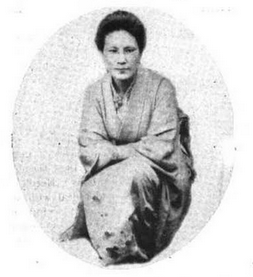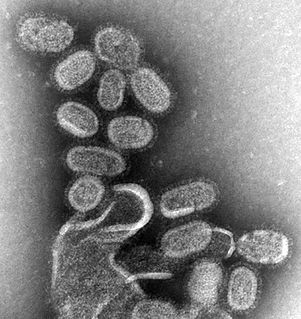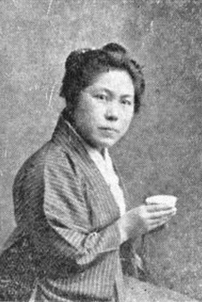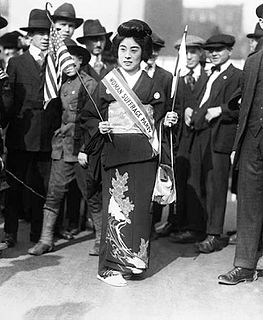
Asako Hirooka (18 October 1849 — 14 January 1919; 広岡浅子 in Japanese; née Asako Mitsui) was a Japanese businesswoman, banker, college founder and late in life, a Christian speaker and writer.

Asako Hirooka (18 October 1849 — 14 January 1919; 広岡浅子 in Japanese; née Asako Mitsui) was a Japanese businesswoman, banker, college founder and late in life, a Christian speaker and writer.
Asako Mitsui was born in Kyoto, the daughter of merchant Takamasu Mitsui. She recalled, as a girl, feeling left out of the education her brothers enjoyed, and being determined after marriage to find a way to learn mathematics, economics, and literature, among other topics. She hired tutors and read independently. "I set myself to the task with the consent of my husband, who was skeptical of my ability and indifferent to my ambitions." [1]

Kyoto, officially Kyoto City, is the capital city of Kyoto Prefecture, located in the Kansai region of Japan. It is best known in Japanese history for being the former Imperial capital of Japan for more than one thousand years, as well as a major part of the Kyoto-Osaka-Kobe metropolitan area.
After an economic crisis, Asako Hirooka moved beyond her traditional life as a wife and mother to rebuilt her husband's family's lost fortunes. [2] She took charge of a coal mine, started a savings bank, started a life insurance company, and invested in Korean agricultural properties. [3]
In 1911, Asako Hirooka converted to Christianity. She wrote for popular women's magazines, with the signature line, "nine times falling, nine times rising again." She spoke at church-run events. [3] She was one of the leaders of the YWCA Summer Conference in 1912, with Kawai Michi, Emma Kaufman, and several others. [4] At her summer home near Mt. Fuji, Hirooka kept a retreat house for Christian preachers. [5]
The World Young Women's Christian Association is a movement working for the empowerment, leadership and rights of women, young women and girls in more than 120 countries. The members and supporters include women from many different faiths, ages, backgrounds, beliefs and cultures. Their common goal is that
[B]y 2035, 100 million young women and girls will transform power structures to create justice, gender equality and a world without violence and war; leading a sustainable YWCA movement, inclusive of all women.

Kawai Michi was a Japanese educator, Christian activist, and proponent of Japanese-Western ties before, during, and after World War II. She served as the first Japanese National Secretary of the YWCA of Japan and founded Keisen University.
Emma Kaufman (1881-1979) was a Japanese-Canadian activist and philanthropist who worked as an international YWCA administrator. For over 25 years she served as a secretary on the staff of Tokyo Y.W.C.A., and also a member of the national Y.W.C.A. committee of Japan. In 1929 she was honored for her distinguished service to the Japanese Y.W.C.A. by being presented with the Emperor's silver cup. During the Golden Jubilee celebration of the "Y" in Japan, a special ceremony was held for the unveiling of a bust of Kaufman. In 1941 Kaufman was appointed by the world's Y.W.C.A. executive committee to make a survey of the British West Indies. In 1965 she received an International Cooperation Year medal from Cardinal Leger at a ceremony in Montreal. Kaufman is a daughter of the founder of the K-W Y.W.C.A.
Raicho Hiratsuka, a student at Japan Women's University, which Hirooka helped to found, [6] recalled her scolding the students for studies she deemed too "theoretical"; she thought the young women should pursue a more practical education. [7]

Japan Women's University is the oldest and largest of private Japanese women's universities. The university was established on 20 April 1901 by education reformist Jinzo Naruse.
Asako Mitsui married Shinjirō Hirooka in 1866. They had a daughter, Kameko. Asako Hirooka died in 1919, aged 69 years, in Tokyo, [8] [9] from influenza, during the worldwide epidemic. [10]

Influenza, commonly known as the flu, is an infectious disease caused by an influenza virus. Symptoms can be mild to severe. The most common symptoms include: high fever, runny nose, sore throat, muscle pains, headache, coughing, sneezing, and feeling tired. These symptoms typically begin two days after exposure to the virus and most last less than a week. The cough, however, may last for more than two weeks. In children, there may be diarrhea and vomiting, but these are not common in adults. Diarrhea and vomiting occur more commonly in gastroenteritis, which is an unrelated disease and sometimes inaccurately referred to as "stomach flu" or the "24-hour flu". Complications of influenza may include viral pneumonia, secondary bacterial pneumonia, sinus infections, and worsening of previous health problems such as asthma or heart failure.
A period drama based on the life of Asako Hirooka, Asa ga Kita , appeared on Japanese television in 2015 and 2016. It starred Haru as Asako Hirooka. [11]
Asa ga Kita(あさが来た, Here Comes Asa!) is a Japanese television drama series which was broadcast by the 93rd Asadora six days a week on NHK between September 28, 2015 and April 2, 2016. It is based on the life of Asako Hirooka. It was followed by Toto Neechan on April 4.
Haru is a Japanese actress and model, known for the film Koizora (2007), Maria-sama ga Miteru (2010), the TV drama Asa ga Kita (2015-2016), and for co-hosting of the TBS talk show A-Studio.

Fukuda Hideko was a Japanese author, educator and feminist of the Meiji period in Japan. Born Kageyama Hideko, she was educated at a young age and would pursue socialist and feminist goals for most of her adult life. She was a participant in the Osaka Incident of 1885, where approximately 130 liberal activists were arrested on their way to attempt to incite revolution and liberate Korea. The group had planned to provide guns, bombs, and manpower to support reformist movements in Korea before the police intercepted them. After being freed, Fukuda continued to pursue social and gender reforms in Japan, playing an active role in the Freedom and People's Rights Movement which pushed for democratic changes to the government. She would eventually establish the magazine Sekai Fujin, which aimed at empowering women in Japan and getting them involved in international affairs. Throughout her life, Fukuda was involved in Japanese reform movements as they transitioned from aiming on increasing citizen's political rights to the more socialist-focused waves which attempted to exact nationwide social and economic revisions.

Clara Kimball Young was an American film actress, who was highly regarded and publicly popular in the early silent film era. She married fellow actor James Young (director) who went on to direct films.

Rumiko Takahashi Anthology, also known as Rumic Theater, is a manga collective composed of many short stories written and illustrated by Rumiko Takahashi. New stories are published annually in Shogakukan's Big Comic Original magazine since 1987. In Japanese it has been published under several different names, including Takahashi Rumiko Gekijō (高橋留美子劇場) and Takahashi Rumiko Kessakushū (高橋留美子傑作集). Some editions are numbered 1–3 while other editions are unnumbered; volume 5 currently only exists in an unnumbered edition. It is also a thirteen episode collection of anime from short stories by Rumiko Takahashi that includes the Mermaid Saga.

Feminism in Japan began in the late 19th century near the end of the Edo period. There have been traces of concepts in regards to women's rights that dates back to antiquity. The movement started to gain momentum after Western thinking was brought into Japan during the Meiji Restoration in 1868. Japanese feminism differs from Western feminism in the sense that less emphasis is on individual autonomy.
Tomoka Shibasaki is a Japanese writer from Osaka. She has won the Noma Literary New Face Prize and the Akutagawa Prize, and two of her works have been adapted for film.

Edith Jessie Archibald was a Canadian suffragist and writer who led the Maritime Women's Christian Temperance Union (WCTU) and the National Council of Women of Canada and the Local Council of Women of Halifax. For her many forms of social activism, she was referred to as the "Lady of Grace" by King George V, and she was designated a Person of National Historic Significance by the Government of Canada in 1997.

Hiratsuka Raichō was a writer, journalist, political activist, anarchist and pioneering Japanese feminist.

Bluestocking was Japan’s first all-women literary magazine created in 1911 by a group of five women. Haru Raichō Hiratsuka, Yasumochi Yoshiko, Mozume Kazuko, Kiuchi Teiko, and Nakano Hatsuko founded the Japanese Bluestocking Society to promote the equal rights of women through literature and education. The magazine they developed was designed to articulate women’s self-awareness and the gender-based societal limitations they faced, but its promotion of early feminist beliefs through controversial publications caused it to be banned by Japanese kokutai for being “disruptive to society”. Bluestockings was in print only in Japan from 1911-1916 but the response it caused is credited as prompting the pioneering movement of Japanese feminism.

Edith Picton-TurbervillOBE was an English social reformer, writer and Labour Party politician. From 1929-1931, she served as the Member of Parliament for The Wrekin in Shropshire.
The women's suffrage in Japan can traces its origin back to democratization brought by Meiji Restoration, and blossomed in the 1920s during the Taisho democracy.
Takamure Itsue was a Japanese poet, activist-writer, feminist, anarchist, ethnologist and historian.

Yajima Kajiko was the founder of the Women's Reform Society and president of Japan's Woman's Christian Temperance Union. An educator, pacifist, and Christian activist, she vigorously advanced the cause for the education of women in Japan. Her name was usually seen as Kaji Yajima in the American press of her day.

My Little Monster is a Japanese manga written and illustrated by Robico about the relationship between a girl named Shizuku Mizutani and a boy named Haru Yoshida. It was serialized in Kodansha's Dessert magazine from August 23, 2008 to June 24, 2013. An anime adaptation by Brain's Base aired from October 1 to December 24, 2012. It was also streamed on Crunchyroll during its original run.
Asako is a feminine Japanese given name. Notable people with the name include:
Oku Mumeo was an important Japanese feminist politician who served three terms in Japan's Imperial Diet after having been a leader in the early modern Japanese suffrage movement. She played an important role in various early Japanese women's rights movements and she was a crucial part of Japan's consumer movement. She was a renowned activist in the 1920s, co-founding the New Women's Association with Hiratsuka Raichō and Ichikawa Fusae, and eventually held a seat in the House of Councilors from 1947 to 1965 when she retired.
The New Women's Association was a Japanese women's rights organization founded in 1920. The organization strove to enhance women's rights in the areas of education, employment, and suffrage. It also aimed to protect women from venereal disease by attempting to prevent men with these diseases from marrying, as well as by allowing women whose husbands had these diseases to get a divorce. The organization played an important role in changing Article 5 of the Public Peace Police Law, which had prohibited women from participating in public meetings. NWA also enlisted the help of men as advocates for women in politics.

Tomo Inouye was a Japanese medical doctor, trained at the University of Michigan Medical School. She was the founder of the Japanese Medical Women's Society.

Komako Kimura (1887-1980), also seen as Komaku Kimura or Komago Kimura in American newspapers, was a Japanese suffragist, actress, dancer, theatre manager, and magazine editor before World War II.

Sarah Jane Dawes Shedd was an American missionary teacher, serving Assyrian Christians at Urmia in Persia.